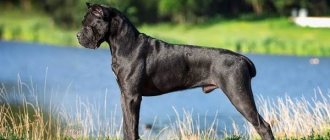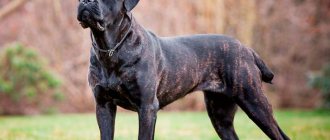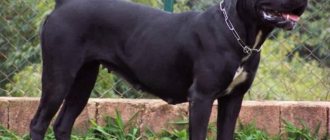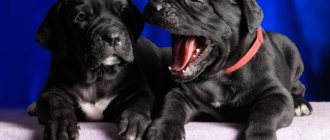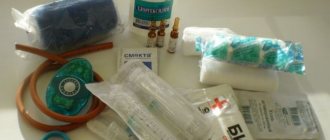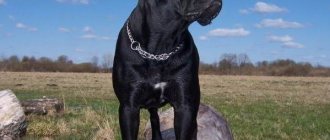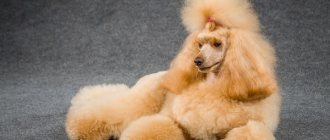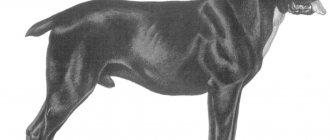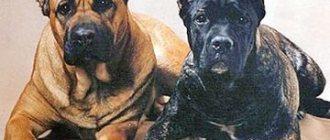Whether a Cane Corso puppy will be blue, red, brindle or black depends on its parents. Therefore, serious breeders select dogs for breeding based on science.
This is done not only for the beauty of the offspring, but also to comply with color standards, because the color of the coat indicates either the purity of the breed or a “marriage”.
We will try to talk about all the color options and how they are obtained. Knowing the basics, you can wisely choose a puppy or a mate for an adult pet - to get babies of the right color.
Colors and colors
The range of acceptable colors is quite wide. If you want to get a Cane Corso, take a closer look at the puppies of the following colors: - black; — all shades of gray; - light red; - dark red, to the color of mahogany with black hair or black tips (this color is also called murugim); - brindle - stripes on red or gray fur.
Red and brindle cats must have a black or gray mask on the face, not extending beyond the line of the eyes. They are not white, but small white spots are allowed on the chest, bridge of the nose and tips of the paws.
Large white markings, white eyelids or nose, blue eyes (even partially), long or wavy coat are considered disqualifying faults.
For some time now, people who want to have a Corso have been interested in “fashionable” colors - Isabella, Formentino, apricot, chocolate, tan - but they should only focus on the standard described above.
Isabella sounds pretty, but it's actually a disqualifying color. This is a light light gray without a mask. Connoisseurs do not take males of this color for mating; females - very rarely. Professional breeders do the same in their homeland - Italy.
Representatives of the breed that are too light are sent “overboard.” Tan - black or gray with red spots on the chest, muzzle and paws - also fits into the standard. Apricot and chocolate are usually light red and light brown without a mask. As you can see, they are also “not noble.” Formentino is a little more complicated.
Most breeders mean light tan with a gray or blue (lighter) mask, but some also call dogs of this shade without a mask. Be careful, because the first option is included in the standard, the second is not.
On the other hand, if you and your pet are not going to go to shows and prestige is not important to you, you can buy a puppy of any color. The color will not affect his character and service qualities.
Cane Corso puppies
All Cane Corso puppies are very similar to each other, and choosing a model pet is not easy.
When choosing a puppy, you need to pay attention to:
- the conditions in which dogs live;
- availability of documents for puppies;
- absence of dysplasia;
- presence of pedigree;
- the appearance of the puppy;
- breeder behavior.
Puppies are divided into show, breed and pet - these are classes that reflect the future of the dog.
The show class will shine at exhibitions, the breed will be future producers, the pet will be pets. The price will naturally vary. A Cane Corso puppy is not cheap, you will have to pay from 250 to 1500 dollars for it.
We must understand that the pet class is not a marriage; if you do not plan to breed a Cane Corso and participate in exhibitions with him, but are simply looking for a friend, this will be a faithful companion .
Currently, there are many nurseries where Cane Corso is bred, since the demand for puppies of this breed is constantly growing. When choosing a baby, it is very important to observe how he behaves - he should be brave, energetic and friendly. You also need to see how the baby eats - a healthy puppy eats with appetite.
It is important to match your temperament to that of your puppy; calm people leading a measured lifestyle are unlikely to be suitable for a daredevil puppy.
The puppy must have a birth certificate and a veterinary passport with all vaccinations and helminth prevention.
Such a document is issued 45 days after the birth of the baby . There should be a mark on the dog’s belly, it coincides with what is in the metric.
The owner must take into account that expenses do not end after purchasing a puppy.
The cost of the dog is just the beginning. The puppy will need the services of a qualified veterinarian, will need to pay for participation in exhibitions, and pay for membership in the club.
The Cane Corso is a large dog, therefore, feeding the pet will also require expenses .
Caring for puppies is not difficult. If the dog is healthy, its fur has no odor. Shedding occurs twice a year, and since the dog's coat is short, it does not require any special care. It is enough to clean it twice a week with a special brush.
If after a walk your Cane Corso puppy resembles a pig, you need to bathe him in warm water without shampoo. If the dog is very dirty, you can bathe it with shampoo.
There are dry shampoos that simply wet the dog and then wipe it dry..
Calluses and bald patches often form on Cane Corso elbows. To prevent their appearance, these places should be lubricated with ointments against subcutaneous parasites.
As for the ears, once a week you need to remove accumulated dirt behind them. If the ears smell unpleasant and the dog shakes its head, consult a doctor.
No special care is required for the eyes; you should only contact a doctor if the dog squints, blinks frequently, or constantly rubs its eyes.
If the nails grow back too quickly, the dog will feel pain and the puppy's limbs may not form properly. As a rule, the claws are worn down while running or walking, but sometimes there is a need to correct the claws with special nippers.
A puppy's milk teeth begin to change to permanent ones at 3 months . At this time, the owner should introduce foods containing calcium into the dog’s diet.
To make teeth change faster, you can give your puppy a tendon bone, a carrot, or an edible toy.
To form the correct bite during the period of changing teeth, you need to play tug with the puppy, and be sure to carefully examine the teeth.
If the baby tooth has not yet fallen out, but a permanent tooth is already visible in its place, a veterinarian consultation is necessary.
Coat color
The color of the coat depends on the pigment melanin. The same one that is responsible for the color of skin and hair in humans. It can be in the form of pheomelanin or eumelanin. The first leads to the formation of yellow and red (bright red) shades of color, the second – black and dark brown.
They cannot be present in the body at the same time. But what exactly the color of a newborn puppy will be is decided by genes. More precisely, the alleles of those genes that determine the phenotype, in other words, the appearance of the dog.
In this case, the puppy will not necessarily receive the color of its father or mother. If their genotypes have two variants of the same gene - recessive and dominant - then their coat color is determined by the dominant one, and they can pass on the recessive one to the puppies.
For example, allele B gives black color. He is dominant, which means the dog will be black. But if the same gene has a recessive allele b, and the offspring inherit it from both parents, they will turn out brown.
Also, a gene region (locus) E may have alleles E, Em, e. Of these, Em is dominant; it is responsible for the formation of the mask on the dog’s face. E gives a uniform color, and the “weakest” allele e completely deprives the coat of black color, and puppies that inherited only it will be born non-standard - red color without a mask.
And if a red-haired baby has a mask, he definitely received the k allele from his father and mother. All individuals who inherited the same allelic genes from their parents are called homozygous (kk, DD, BB, ee). If the dog is heterozygous (Bb, Dd), then the dominant gene will determine the color of the coat.
There is an opinion that black Cane Corsos have Great Danes in their pedigree, fawn and brindle dogs have Staffordshire Terriers and Boxers, and gray dogs have Mastino Neapolitans.
Content
- What is color and suit in dogs
- Colors of the Cane Corso breed
- How to choose a healthy puppy
When a person chooses a pet, he gives preference not only to a certain breed, but also focuses his attention on the color; it comes in different shades and colors, striking with its beautiful patterns and appearance. Genetics is one of the main points in a dog’s appearance; the color, type of coat and proportions depend on it. Check out the colors of the Cane Corso breed.
Color options when mating with different coat colors
Let's now take a closer look at what color options are possible when breeding dogs with different coat colors.
Absolutely black parents can produce not only black puppies, but also blue (a shade of gray), brindle, blue-brindle with a blue mask, red with a black mask and fawn with a blue mask.
Also, black parents may have a gray baby with black eyelids, lips and a gray nose. The black color is not caused by any one gene, but by the combination Ay-BD-Em-K-. You can see for yourself how much space Mother Nature has for creativity.
If you breed brindles, they will also give a variety of offspring, but there will be no black babies.
At the same time, if one of the parents has a solid color, but has at least one tiny “tiger”, he can no longer pass on the gene necessary for the formation of black color. In brindle dogs, the puppies will be brindle with a black mask, red with a black mask, blue brindle with a blue mask, or fawn with a blue mask.
If blue brindle and blue dogs are bred, then all the offspring will be light colors: the same colors as the mother and father, or light red with a blue mask, formentino.
Parents who are red with black or blue masks will produce red puppies with a black mask or fawn with a blue mask.
If you study the genetics of colors in detail, you can control the color of the coat of future babies.
History of the breed
The Cane Corso is the heir to the ancient Tibetan Great Danes or Molossians. When the descendants of the Molossians arrived in the Roman Empire, they began to be used in military campaigns, in arena battles and to protect territories.
In ancient chronicles, Cane Corsos are characterized as tireless, fearless and loyal dogs.
The official history of the Cane Corso begins with the active prosperity of the Roman Empire, but when this empire fell, the new aristocracy did not keep the Cane Corso in their yards..
As a result, the breed began to mix with others and was on the verge of extinction.
In the 70s of the last century, interest in the breed awakened again, and in the 80s, cynologists drew up an official breed standard, which received a positive assessment from experts in 1994.
Currently, the Cane Corso is a very popular breed, the demand for which is constantly increasing.
Genotype of parents and non-standard colors
To avoid the appearance of puppies of undesirable colors, it is necessary to take into account the genotype of the parents. Any non-standard color is the result of a fusion of recessive alleles, and indicates that the parents have them. If both are standard colors, then they are heterozygous.
For example, black and tan dogs have the genetic formula atatB-D-Em-kbr-.
It is worth noting that sometimes brindle dogs have very wide gray or black stripes, to the point that they occupy almost the entire surface of the body. They can be confused with tans.
To understand what the color actually is, you need to look at the color of the paws - in a Cane Corso with tan they will be lighter than the body. Brown without a mask is the result of a match of alleles bb: Ay-bbD-Em-K-.
Isabella is obtained by “meeting” the bbdd alleles. Then the dog will be creamy, sometimes with a hint of blue or chocolate, without a mask, with a pink nose, eyelids and lips. The fact is that these alleles weaken the black pigment to gray, and, on the contrary, give free rein to the brown one.
The result is such a non-standard mixture.
If the puppy received her alleles, you will not find a single dark hair on his body. He will be completely red. Only the nose, lips and eyes can be black, gray or brown. Sometimes they say about this color that it is acceptable for participation in competitions and exhibitions, but it is better not to risk it if this is important to you.
There are cases when pure redheads were considered redheaded, with a weakly defined mask. This is mistake.
The reason why dogs of undesirable colors are avoided for breeding is very simple. If one parent is “standard” and the other is not, the puppies, as a rule, are born of the “correct” colors, but they will still have recessive alleles in their genotype, which means that in the future they can produce “defective” offspring.
Custom ones are harder to sell and cheaper. If you have anything to add to the article, please share your thoughts in the comments.
Please like it. This will help the project develop.
Dog character
The Cane Corso is a guard, ready at any moment to protect the family in which he lives from enemy attack.
Moreover, he perfectly differentiates not only people, but also animals into friends and strangers.
Cane Corso have a strong attachment to their owner, and in his absence they become very sad and may even experience a feeling of panic . Loneliness is extremely difficult to tolerate.
The Cane Corso can attack an enemy even without the owner's command, but only if the owner is in real danger.
As for their attitude towards other dogs, Cane Corsos are not the first to attack, but they tend to succumb to provocation.
NOTE!
They may well coexist with other animals, including cats, especially if the animal was adopted by a family when it was a kitten.
This is an excellent protector and friend for children; they are very careful with family members who are significantly weaker than them..
Cane Corso are lively and active dogs that are suitable for people who live in their own home and have a persistent character.
Read more about the character traits of the Cane Corso here.
